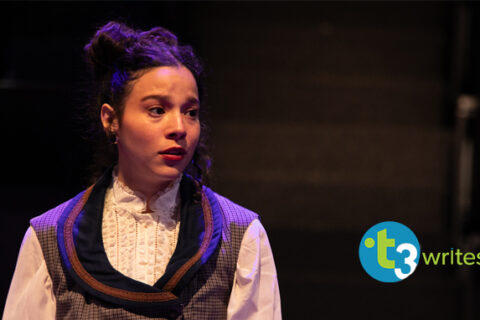The Highs and Lows of a Diabetic Actor
By Ian Ferguson
As any actor will likely tell you, our job is a very particular and – let’s just say it – strange one. It’s highly specialized and entirely subjective. Everyone has their preferences and methods and none of it is wrong (except the ones I don’t like. Those are wrong). Not everyone can do it. Not everyone wants to. And some want to but don’t get to as often as they’d like. But another odd feature of being an actor, in my experience, is the frequency with which people who aren’t actors will tell you how much they know about it. Not all subjects, or even all art, is like this. People that don’t paint will tell you they know nothing about it. People that don’t dance (hi. That’s me) will openly tell you they can’t move that way. Nobody fakes being a musician. There’s something about acting that seems to make people feel inherently knowledgeable on the topic. Maybe it’s the presumed familiarity of using your voice and saying words. Everyone gets that, so that’s it. That’s what acting is. Or maybe they feel like they are supposed to have a connection to it somehow. “Oh, you’re an actor? My niece does drama.” Or “I’ve done a little acting myself. We do skits at our corporate training events.” Or “what would I have seen you in?” No malicious intent of course. They operate on their own level of understanding and engage in good faith – most of the time.
As any diabetic will tell you, it is a complex disease. There’s more than one version of it. It’s increasing rapidly in the population. It requires constant attention and management. But an odd feature of diabetes is the frequency with which people who are not diabetic will tell you how much they know about it. Not all diseases are this way. I would guess most diseases are topics people either avoid or have no problem telling you they don’t know about. People are generally very teachable about disease. But with diabetes, people feel they have a requisite baseline of knowledge about it. Maybe because it is a regular topic in media. Maybe because they worked with someone who had it. Maybe because it has become something of a punchline disease. It’s casual. It’s something to do with sugar and weight and bad habits. “Wilfred Brimley told me about it. ‘Diabeetus’ right. Haha.” Again, people aren’t trying to be mean or crass. But they aren’t curious about it either because there’s a sense that everyone already understands it.
I am an actor with type 1 diabetes. So, I have the above conversations with a lot of people a lot of the time. I don’t know that I can help strangers understand how my profession is probably different than they think, but maybe I can dispel some myths about Diabetes and use my profession to frame it.
Let’s start with some basics. Type 1 diabetes and type 2 diabetes are not the same. They are completely separate diseases. They both get labeled “diabetes” because the end result is that both have issues with pancreas function. Type 2 diabetics have a low functioning pancreas. Type 1 has a NO functioning pancreas. The pancreas releases insulin when you eat, and that insulin processes the glucose that your body is taking in from food. It makes it usable. All carbs, whether from sugar or not, will turn to glucose in your body. For those with a low functioning pancreas, if they reduce carb intake, that most often addresses the issue. This is not the case for me. I have no way to process glucose naturally. Lastly, type 2 diabetes most often develops in a person after years of habits – what one eats, doesn’t eat, how much of it they eat, exercise or lack of it, etc. Doesn’t happen to everyone with those habits, but that’s how it goes. Type 1 diabetics just…are. It’s an autoimmune disorder and it just happens. Sometimes there’s family history. In my case there wasn’t. I was 17 with a normal growing human body. Then one day my immune system got confused and saw my pancreas as a foreign object and attacked it until it stopped. No rhyme. No reason. In fact, it’s something doctors still don’t have a full explanation for.
So that’s a lot. Even for being the basics. So, what does any of this mean? I can’t process glucose, so what? Well, the fact is, despite the casual use of “diabetes” as a joke about eating a donut or a comment on modern American laziness, diabetes is incredibly dangerous. Deadly. In fact, until the early twentieth century, before they figured out how to extract and use pig insulin, type 1 diabetes was a death sentence. Fully terminal, within a couple of years. When you can’t process glucose, all that glucose is in your blood, and it’s poison. It will in fairly short order begin to ruin any organ that blood deals with, which is all of them. So back then they would put you on “starvation therapy.” Basically, you’d eat lettuce and drink water and live a few years. That’s the best they could do. Now a hundred years later, there have been a ton of advances, but ultimately, it’s still about insulin therapy (no longer from pigs, btw). I manually inject what most bodies produce themselves. Every day, several times a day. That insulin then does its job. It processes glucose and keeps it out of my blood as best it can.
“Ian, this is dark and boring and not about theatre!!!” I know. Bear with me.
Non-diabetic’s insulin systems are automated. Naturally regulated. The pancreas is a pro. It delivers the right amount and only right amount and when it needs more, it makes more. Since that management is done by me instead of my free-loading pancreas, I can get it wrong. And I do. Don’t inject enough insulin, blood sugar goes up (dangerous in the long run). Too much insulin, blood sugar goes down (possibly dangerous immediately). So, it’s about keeping it down but not too down for as long as possible. Kind of a one-man ping pong game. Additionally, increased activity will cause my body to respond more sensitively to insulin. So, the measurements all change. Actually, they constantly do. With age, if I’m sick, if I’m tired – any number of factors change how those calculations are done, but the goal remains – keep it neither high or low for as long as possible and address it when it goes wrong.
So. Theatre. Obviously, I take my diabetes everywhere. I don’t get to press pause when I’m performing. So, for me, in addition to the preparation and the mindset and the routines I maintain to do my work onstage, I also have to strategize how I, with the help of whatever theatre company I’m working with, can manage avoiding emergencies but also dealing with them if they arise. That means having a lot of the conversation I’m typing out now with my director, my stage manager, any assistant stage managers or crew, and at least some cast members if not all. It means bringing a lot of small bottles of juice and spreading them out in backstage areas and hiding them somewhere on stage – which may mean working with the set designer as well. If my blood sugar dips below 80 and looks like it’s going to keep going, I have to have access to that juice immediately. But the show must go on, right? That’s the idea, and so far, it always has. In one production, I played Thomas Jefferson and never left stage, so my costume designer created a pocket in the beautiful coat she’s made and provided me with a flask of apple juice to place in it. If I felt that my sugar was dropping to a dangerous level, Thomas need only take a pull of “whiskey” during the play. Not in the script of course, but an elegant solution to help me stay safe while allowing me to do the strange job I love. It means keeping an eye on my blood sugar readings – I have a constant monitor that updates me every five minutes. But that monitor has to stay backstage. So, every chance I get, I check. And my backstage crew keeps an eye on it for me too in case I’m in danger and don’t know it. And if the numbers get too high, I have to find a pocket of time before my next entrance to inject more insulin that hopefully isn’t too much insulin.
None of these activities or concerns are special to my journey as a type 1 diabetic. But most type 1s don’t have to pretend they don’t have it. For a couple of hours every now and then, I do. The trick for me is keeping it a secret from my characters so they can keep it from the audience. None of the characters I’ve played so far are diabetic. So that concern has to be partitioned from what I’m doing on stage, but it can’t go away either. I have had both high and low blood sugar on stage. I have consumed juice on stage, disguised as something else or as a natural act of my character. The commitment is to the work as much as it possibly can be. So, hiding in plain sight is the constant game. The only story I want to tell onstage is the one I was hired to tell. But this is my story backstage. Remembering lines and notes and blocking. Knowing which costume change happens when. Recalling the fictional backstory that informs all of my actions under those lights. Feeling the nerves as people fill the seats in the house. Accepting the singular exhilaration when the joke lands and a hundred strangers laugh out loud. And being just worried enough about a disease I’ll never not have that threatens me at all times and requires constant attention.
There’s not really anything casual, or – despite the dark jokes I might even make about it in person – terribly funny about performing while managing type 1 diabetes. It requires a lot of presence of mind; a mind already distracted with the thousands of details involved in putting on a show. And it requires the support of a lot of other caring theatre artists too. Every actor struggles for the chance to do what we do. We give our hearts and our bodies to it. This is the way I give mine, and I’m happy to do


